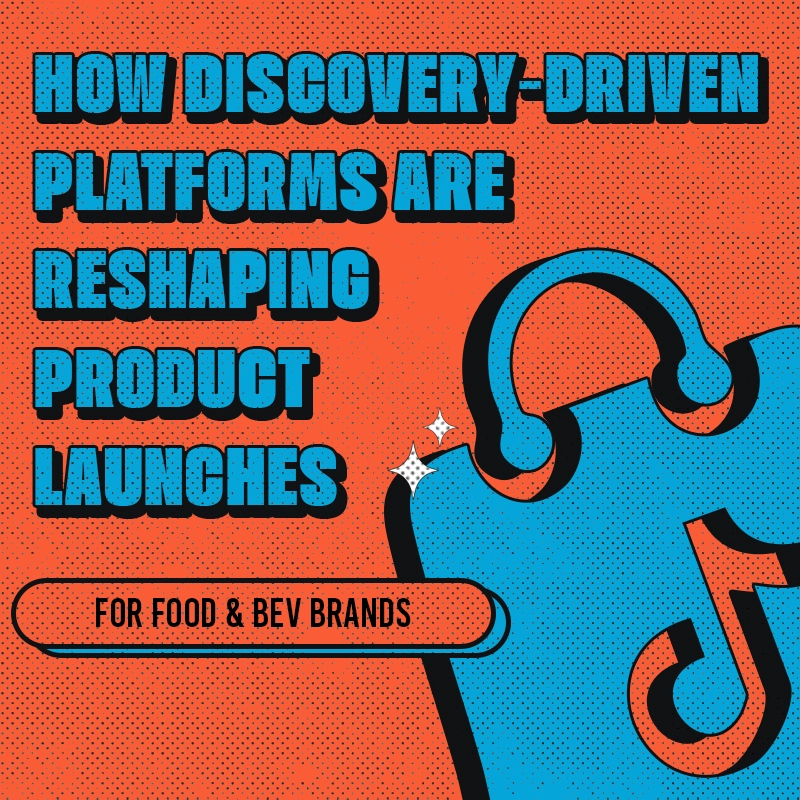



Food and beverage brands have long relied on shelf placement, paid ads, and in-store promotions to launch new products. As marketing strategies evolve, platforms like TikTok Shop now give brands the ability to reach audiences faster through creator-driven storytelling and organic discovery.
The numbers highlight this shift. TikTok Shop surpassed $70 billion in gross merchandise value since launch, and active U.S. shops increased from roughly 4,500 to more than 230,000 in two years (Retail TouchPoints, 2025). Food and beverage sales are growing at double the rate of the platform overall.
This pattern shows how discovery-driven commerce compresses the traditional launch funnel. Awareness, trial, and purchase can now happen in one session. Audiences move from discovery to purchase in seconds, guided by authentic creator content instead of polished ads.
For marketers, this shift redefines how campaigns are planned, tested, and measured. It’s no longer about perfecting a message before launch, but about learning directly from the audience as it happens.
1. Faster Product Development
Retailers now respond to online trends in weeks instead of months. When items like matcha desserts, “Dubai chocolate,” or freeze-dried candy went viral, brands and private labels launched quick versions to catch the surge.
Smaller producers can use real-time creator data to make decisions faster. Snack companies, for example, are testing limited-edition flavors before scaling up to national production.
2. Creators as Launch Partners
Influencers have become core partners in product introductions. Micro-creators with loyal communities often drive stronger engagement than celebrity sponsors.
Retail Brew reports that small brands such as EZ Bombs reached visibility comparable to larger competitors by focusing on consistent creator collaborations instead of major ad buys (Retail Brew, 2025). Around two-thirds of TikTok Shop sales in the U.S. now come from pre-recorded creator videos rather than livestream events (Retail TouchPoints, 2025).
This shift has leveled the playing field, allowing smaller brands with creativity and audience connection to compete effectively.
3. Discovery as a Retail Demand Signal
TikTok trends now influence which products land on store shelves. Viral interest in niche foods has pushed distributors to secure stock faster than their usual review cycles.
One example: a brand that reached roughly $19 million in TikTok Shop sales went on to gain national placement at Walmart and Albertsons. Discovery platforms now act as cost-effective testing grounds that help confirm demand before a large-scale rollout.
4. Marketing and Supply Chain Alignment
A viral post can generate thousands of orders in hours. Marketing and operations teams must stay aligned to scale effectively with adaptive packaging, reliable fulfillment, and clear delivery communication.
Several retailers have reported ingredient shortages linked to viral TikTok products such as matcha or honey-based snacks (The Guardian, 2025). Brands that anticipate this type of surge protect both their reputation and their customers’ experience.
From a marketing strategy standpoint, success on discovery platforms depends on agility, community insight, and an authentic content pipeline.
Design Products for Visual Discovery
When developing new items, think about how they appear on camera. Bright packaging, clear textures, or a fun reveal stand out more than static imagery. Variety packs and exclusive bundles encourage trial by offering novelty.
Build Genuine Creator Partnerships
Work early with creators who understand your target market. Allow them to give honest reactions instead of scripted messages. Natural, engaging content performs better than overproduced ads.
Track More Than Sales
Monitor engagement metrics like referral traffic, branded searches, and social mentions. Many companies see TikTok as a key driver of brand visibility that later converts through stores or direct websites.
Treat Launches as Ongoing Experiments
Use each product drop as a learning opportunity. Collect feedback on flavor, packaging, or size, and adapt based on community responses. Consumers value transparency when they see brands refining products based on real experiences.
Freeze-Dried Candy Craze: Small confectioners used TikTok Shop to launch sampler packs inspired by viral freeze-dried candy videos. The trend gained so much traction that national candy brands followed suit.
Dubai Chocolate Bar: A social media trend turned a regional novelty into a retail staple as stores rushed to meet demand. This highlights how consumer interest online can drive physical retail decisions.
Both examples illustrate a clear shift: discovery comes first, retail follows.
TikTok Shop has turned social discovery into a core launch platform for consumer goods. For food and beverage companies, success depends on visibility through relatable creators, flexible production, and responsiveness to real-time audience behavior.
Brands that treat these platforms as collaborative spaces — where storytelling, community input, and experimentation drive growth — can bring new products to market faster and with more relevance.
The next generation of food brands will grow from both the digital feed and the store shelf, shaped by what people discover, share, and enjoy together.
